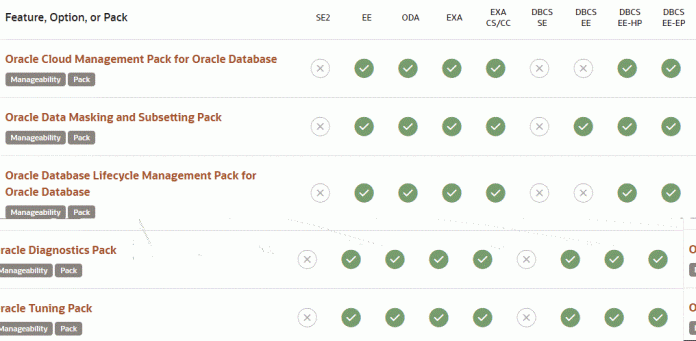After being asked on daily basis all kinds of questions on Oracle Database Licensing, as time goes by, you sort of understand it. Sort of, because the Oracle Database Licensing Guide is 602 pages long and gets often updated. The latest one is from April 2021 – now it is mid-May.
Moreover, you have perhaps seen all Oracle certifications but if you search for one on licensing you will find what I did – there isn’t one.
What I am trying to do now, is to summarize Database Licensing in a short blog post – this might be helpful for many to at least understand the concept.
There are 3 types of licenses for the Oracle Database: Packs, Options and Features and 9 Oracle Database Offerings: Standard Edition 2, Enterprise Edition, Oracle Database Appliance, Exadata, Exadata Cloud Service and Cloud@Customer, Database Cloud Service Standard Edition, Database Cloud Service Enterprise Edition, Database Cloud Service Enterprise Edition – High Performance and Database Cloud Service Enterprise Edition – Extreme Performance (you can see their abbreviations in the table below).
Packs: there are 5 different packs for the Oracle Database:
2. Options: there are 15 database options for the Oracle Database:
Here are the ones related to Consolidation, HA, Managability and Performance:
3. Features: there are 131 features that can be licensed with the Oracle Database out of which 105 are for EE and 123 are for Exadata. As you can see, there are 3 features available for Exadata, ExaCS and ExaC@C falling under the functional category of Autonomous:
If you would like to drill down in detail, use the Database Feature and Licensing tool which is available online without the need to register or have an Oracle account.
Moreover, the Oracle Enterprise Manager Licensing Manual is 366 pages, so there is more to read if you are done with the Database Licensing Manual.
You might think that is way too much for me, and perhaps it is, but the situation is very similar with other database vendors. Let us look at AWS and GCP for instance:
AWS have more than 10 database offering:
Amazon Aurora
Amazon RDS
Amazon Redshift
Amazon DynamoDB
Amazon ElastiCache
Amazon DocumentDB (with MongoDB compatibility)
Amazon Keyspaces (for Apache Cassandra)
Amazon Neptune
Amazon Timestream
Amazon Quantum Ledger Database (QLDB)
AWS Database Migration Service (DMS)
GCP have also more than 10 database offerings:
Relational: Bare Metal Solution for Oracle workloads
Cloud SQL: Managed MySQL, PostgreSQL and SQL Server
Cloud Spanner and BigQuery
Key value: Cloud Bigtable
Document: Firestore and Firebase Realtime Database
In-memory: Memorystore
NoSQL: MongoDB Atlas and managed offerings from open source partner network including MongoDB, Datastax, Redis Labs, and Neo4j
And, after all, Azure are not much behind:
Azure SQL Database
Azure SQL Managed Instance
SQL Server on Virtual Machines
Azure Database for PostgreSQL
Azure Database for MySQL
Azure Database for MariaDB
Azure Cosmos DB
Azure Cache for Redis
Azure Database Migration Service
Azure Managed Instance for Apache Cassandra
After all, being expert in database licensing in a skill of its own!
Read MoreJulian Dontcheff’s Database Blog


